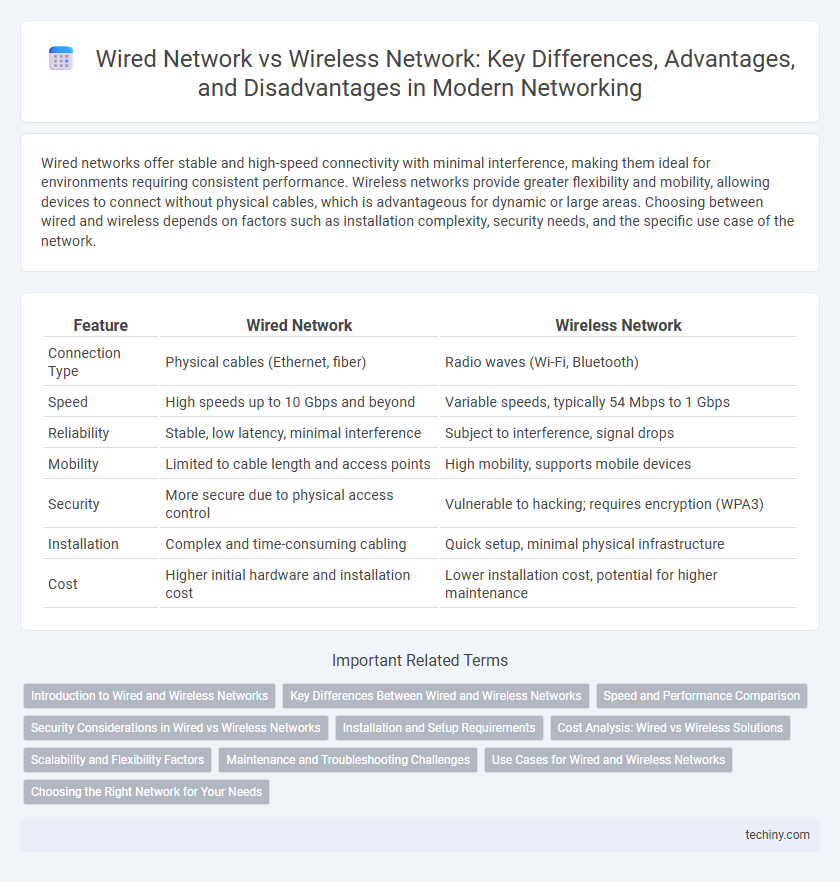Wired networks offer stable and high-speed connectivity with minimal interference, making them ideal for environments requiring consistent performance. Wireless networks provide greater flexibility and mobility, allowing devices to connect without physical cables, which is advantageous for dynamic or large areas. Choosing between wired and wireless depends on factors such as installation complexity, security needs, and the specific use case of the network.
Table of Comparison
| Feature | Wired Network | Wireless Network |
|---|---|---|
| Connection Type | Physical cables (Ethernet, fiber) | Radio waves (Wi-Fi, Bluetooth) |
| Speed | High speeds up to 10 Gbps and beyond | Variable speeds, typically 54 Mbps to 1 Gbps |
| Reliability | Stable, low latency, minimal interference | Subject to interference, signal drops |
| Mobility | Limited to cable length and access points | High mobility, supports mobile devices |
| Security | More secure due to physical access control | Vulnerable to hacking; requires encryption (WPA3) |
| Installation | Complex and time-consuming cabling | Quick setup, minimal physical infrastructure |
| Cost | Higher initial hardware and installation cost | Lower installation cost, potential for higher maintenance |
Introduction to Wired and Wireless Networks
Wired networks use physical cables, such as Ethernet, to connect devices directly, ensuring stable and high-speed data transmission with minimal interference. Wireless networks rely on radio waves or infrared signals, allowing devices to connect without physical cables, offering greater flexibility and mobility within a defined range. Both network types serve essential roles in modern communication infrastructure, balancing performance and convenience based on use case requirements.
Key Differences Between Wired and Wireless Networks
Wired networks offer higher speed and more reliable connections due to physical cables like Ethernet, minimizing interference and latency. Wireless networks provide greater flexibility and mobility, utilizing radio frequencies such as Wi-Fi but are prone to signal interference and security vulnerabilities. Key differences include installation complexity, with wired requiring extensive cabling infrastructure, and wireless enabling easy device connectivity without physical constraints.
Speed and Performance Comparison
Wired networks typically offer faster data transfer speeds and lower latency compared to wireless networks, thanks to direct cable connections that minimize interference and signal loss. Ethernet connections can reliably reach speeds up to 10 Gbps, whereas wireless networks, such as Wi-Fi 6, generally max out around 9.6 Gbps under optimal conditions but are more susceptible to environmental factors that reduce performance. Consistent throughput and minimal packet loss make wired networks the preferred choice for bandwidth-intensive applications and environments demanding high reliability.
Security Considerations in Wired vs Wireless Networks
Wired networks offer enhanced security through physical connections, reducing vulnerability to unauthorized access and wireless eavesdropping. Wireless networks require robust encryption protocols such as WPA3 to mitigate risks like signal interception and unauthorized network access. Implementing network segmentation and intrusion detection systems further strengthens security across both wired and wireless infrastructures.
Installation and Setup Requirements
Wired network installation requires physical cabling such as Ethernet cables, network switches, and routers, demanding careful planning for cable routing and hardware placement to ensure optimal connectivity. Wireless network setup relies on configuring wireless access points and routers, minimizing the need for extensive physical infrastructure while requiring strong signal coverage and security measures like WPA3 encryption. Wired setups generally involve higher initial labor and material costs but offer stable performance, whereas wireless networks provide flexibility and easier scalability with less installation time.
Cost Analysis: Wired vs Wireless Solutions
Wired networks typically involve higher upfront costs due to cables, switches, and labor-intensive installation but offer lower long-term maintenance expenses and consistent performance. Wireless networks reduce installation costs and increase flexibility but may incur higher expenses over time from security updates, interference mitigation, and infrastructure upgrades. Businesses must evaluate total cost of ownership, factoring in hardware investment, scalability, and operational efficiency when choosing between wired and wireless network solutions.
Scalability and Flexibility Factors
Wired networks offer superior stability and consistent speeds but face limitations in scalability due to physical cable dependencies and installation complexity. Wireless networks provide greater flexibility with easy device addition and mobility, enhancing scalability in dynamic environments. However, wireless scalability may encounter interference and bandwidth constraints affecting overall network performance.
Maintenance and Troubleshooting Challenges
Wired networks require regular inspection of physical cables and connectors to prevent signal degradation and maintain optimal performance, often demanding more time-intensive troubleshooting due to hidden cable faults or environmental damage. Wireless networks face challenges like signal interference, limited range, and device compatibility issues, making diagnosis reliant on software tools to analyze network traffic and signal strength. Both network types necessitate specialized skills, but wireless environments often complicate troubleshooting by requiring continual monitoring of dynamic spectrum conditions and security vulnerabilities.
Use Cases for Wired and Wireless Networks
Wired networks excel in environments requiring high-speed, reliable connections such as data centers, office LANs, and gaming setups where low latency and consistent bandwidth are critical. Wireless networks offer flexibility and mobility, making them ideal for devices in homes, public hotspots, and enterprise settings with mobile users or IoT deployments. Use cases like video streaming or remote work benefit from wireless convenience, while large-scale data transfers and security-sensitive applications prefer wired infrastructure.
Choosing the Right Network for Your Needs
Wired networks offer superior reliability and faster data transfer speeds, making them ideal for environments requiring stable connections and minimal latency, such as offices or data centers. Wireless networks provide flexibility and convenience, supporting mobile devices and ease of installation in areas where cabling is impractical. Selecting the right network depends on factors like bandwidth requirements, mobility needs, security concerns, and installation costs.
Wired Network vs Wireless Network Infographic

 techiny.com
techiny.com